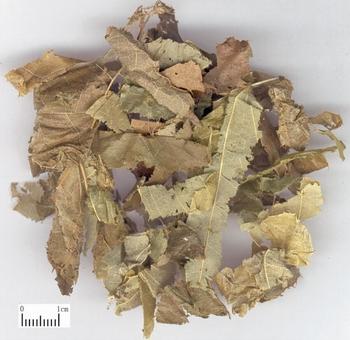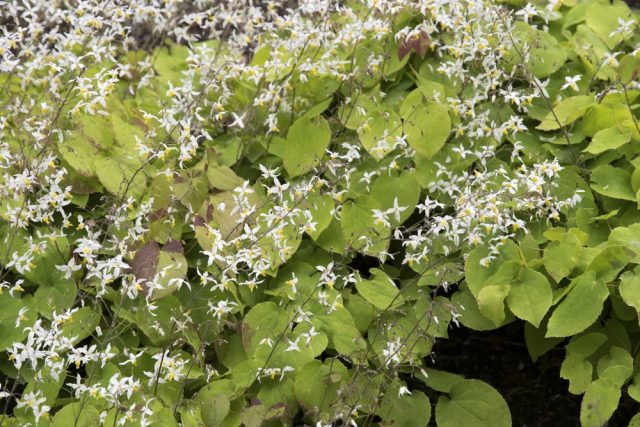 HABITAT:
HABITAT: Epimedium
brevicornu. Epimedium brevicornum,
E. sagittatum, E. pubescens
淫
羊 藿
Yín yáng huò Horny
goat weed, Barrenwort Family: Berberidaceae
Epimedium
brevicornu. Epimedium brevicornum,
E. sagittatum, E. pubescens
淫
羊 藿
Yín yáng huò Horny
goat weed, Barrenwort Family: Berberidaceae


 HABITAT:
Found growing on hillsides, in damp shady bamboo groves or in cliff crevices.
HABITAT:
Found growing on hillsides, in damp shady bamboo groves or in cliff crevices.Icariin from Epimedium brevicornum Maxim promotes the biosynthesis
of estrogen by aromatase (CYP19).
Yang L, Lu D, Guo J, Meng X, Zhang G, Wang F.
Abstract
ETHNOPHARMACOLOGICAL RELEVANCE:
Epimedium brevicornum Maxim has long been used for the treatment of osteoporosis
in China and other Asian countries. However, the mechanism behind the antiosteoporotic
activity of this medicinal plant is not fully understood.
AIM OF THE STUDY:
The present study was designed to investigate the effects of five widely used
antiosteoporotic medicinal plants (Epimedium brevicornum, Cuscuta chinensis,
Rhizoma drynariae, Polygonum multiflorum, and Ligustrum lucidum) on the production
of estrogen, and identify the bioactive compounds responsible for the estrogen
biosynthesis-promoting effect.
MATERIALS AND METHODS:
Human ovarian granulosa-like KGN cells were used to evaluate estrogen biosynthesis,
and the production of 17β-estradiol was quantified by a magnetic particle-based
enzyme-linked immunosorbent assay (ELISA) kit. Further, the mRNA expression
of aromatase was determined by a quantitative real-time reverse-transcription
polymerase chain reaction (qRT-PCR), and the protein expression of aromatase
was detected by western blotting. The activity of alkaline phosphatase (ALP)
in rat osteoblastic UMR-106 cells was measured using p-nitrophenyl sodium phosphate
assay.
RESULTS:
Among the 5 antiosteoporotic medicinal plants, the extract of Epimedium brevicornum
was found to significantly promote estrogen biosynthesis in KGN cells. Icariin,
the major compound in Epimedium brevicornum, was identified to be the active
compound for the estrogen biosynthesis-promoting effect. Icariin promoted estrogen
biosynthesis in KGN cells in a concentration- and time-dependant manner and
enhanced the mRNA and protein expressions of aromatase, which is the only enzyme
for the conversion of androgens to estrogens in vertebrates. Further study showed
that icariin also promoted estrogen biosynthesis and ALP activity in osteoblastic
UMR-106 cells.
CONCLUSIONS:
These results show that the promotion of estrogen biosynthesis is a novel effect
of Epimedium brevicornum, and icariin could be utilized for the prevention and
treatment of osteoporosis.
PMID: 23261485 DOI: 10.1016/j.jep.2012.11.031 J Ethnopharmacol. 2013 Feb 13;145(3):715-21.
doi: 10.1016/j.jep.2012.11.031. Epub 2012 Dec 20. ncbi.nlm.nih.gov
Epimedium brevicornum Maxim extract relaxes rabbit corpus cavernosum
through multitargets on nitric oxide/cyclic guanosine monophosphate signaling
pathway.
Chiu JH, Chen KK, Chien TM, Chiou WF, Chen CC, Wang JY, Lui WY, Wu CW.
Abstract
Epimedium brevicornum Maxim (EbM) has been reputed to have sexual stimulation
effects on males. The study is aimed to test the hypothesis that EbM extracts
relaxed the corpus cavernosum (CC) smooth muscle through activation of multitargets
on nitric oxide (NO)/cyclic guanosine monophosphate (cGMP) signaling pathway.
Water extract of EbM and its subfraction (EP-20) were prepared and standardized
by high-performance liquid chromatography. Isolated rabbit CC strips were mounted
in organ baths and isometric tension was recorded in the presence or absence
of specific inhibitors related to NO/cGMP signaling such as L-N(G)-nitro-arginine
methyl ester (L-NAME), 1H-[1,2,4]oxadiazolo-[4,3-a] quinoxalin-1-one (ODQ, a
guanylyl cyclase inhibitor) or phosphodiesterase 5 (PDE 5) inhibitors. cGMP
level was determined in EP-20-treated CC strips. The results showed that EP-20
enriched the content of L-arginine in the process of purification and relaxed
the CC smooth muscle precontracted with phenylephrine (PE, 1 microM) in a concentration-dependent
manner. Besides, EP-20 increased the amount of cGMP production in rabbit CC
tissues. Coincubation with EP-20 and L-NAME or ODQ significantly decreased EP-20-induced
relaxation whereas EP-20 increased sodium nitroprusside-induced relaxation in
PE-precontracted CC strips. Besides, EP-20 increased the potency and the duration
of the relaxation effects caused by electrical field stimulation. Finally, EP-20
could potentiate PDE 5 inhibitors in relaxation of PE-precontracted CC strips.
We concluded that extract of EbM relax the CC smooth muscle through multitargets
in NO/cGMP/PDE 5 pathway and might bring into perspective the treatment strategy
for those patients with erectile dysfunction.
PMID: 16395327 DOI: 10.1038/sj.ijir.3901437 Int J Impot Res. 2006 Jul-Aug;18(4):335-42.
Epub 2006 Jan 5. ncbi.nlm.nih.gov
Prenylated flavonoids and dihydrophenanthrenes from the leaves of Epimedium
brevicornu and their cytotoxicity against HepG2 cells (Carcinoma).
Pang X, Yin SS, Yu HY, Zhang Y, Wang T, Hu LM, Han LF.
Author information
Abstract
Phytochemical study on the leaves of Epimedium brevicornu finally led to the
isolation of four prenylated flavonoids (1-4) and three dihydrophenanthrenes
(5-7), of which 1, 2, 5 and 7 were new compounds. The structures of these compounds
were established mainly by spectroscopic techniques, including NMR spectroscopy
and mass spectrometry. These isolates exhibited the cytotoxic activities against
HepG2 cells with the IC50 values of 32.8-87.3 μM.
PMID: 29172686 DOI: 10.1080/14786419.2017.1405410 Nat Prod Res. 2017 Nov 26:1-7.
doi: 10.1080/14786419.2017.1405410. [Epub ahead of print] ncbi.nlm.nih.gov
Flavonoid glycosides isolated from Epimedium brevicornum and their estrogen
biosynthesis-promoting effects
Fu Li, Bao-Wen Du, Dan-Feng Lu, Wen-Xuan Wu, Kanjana Wongkrajang, Lun Wang,
Wen-Chen Pu, Chang-Lu Liu, Han-Wei Liu, Ming-Kui Wang & Fei Wang
Abstract
Epimedium brevicornum Maxim has a long history of use in the treatment of estrogen
deficiency-related diseases. However, the chemical constituents and mechanism
of action of this medicinal plant are not fully understood. In the present study,
we isolated four new isoprenylated flavonoid glycosides, as well as 16 known
flavonoids (13 isoprenylated flavonoids), from this plant. The chemical structures
of the new flavonoid glycosides were elucidated by extensive spectroscopic analysis.
The new compounds 1–4 were potent promoters of estrogen biosynthesis in human
ovarian granulosa-like KGN cells. ZW1, an isoprenylated flavonoid analogue and
a specific inhibitor of phosphodiesterase 5 (PDE5), was synthesized and used
to explore the mechanism of the isoprenylated analogues on estrogen biosynthesis.
ZW1 treatment increased estrogen production by upregulation of aromatase mRNA
and protein expression. ZW1 increased the phosphorylation of cAMP response element-binding
protein (CREB). Further study showed that the inhibition of PDE5 by ZW1 increased
estrogen biosynthesis partly through suppression of phosphodiesterase 3 (PDE3).
Our results suggested that the isoprenylated flavonoids from E. brevicornum
may produce beneficial health effects through the promotion of estrogen biosynthesis.
PDE5 warrants further investigation as a new therapeutic target for estrogen
biosynthesis in the prevention and treatment of estrogen-deficiency related
diseases.
Scientific Reportsvolume 7, Article number: 7760 (2017) nature.com